Abstract
This article studies nonlinear, threshold, models in which some of the regressors can be endogenous. An estimation strategy based on instrumental variables was originally developed for dynamic panel models and we extend it to time series models. We apply this methodology to a forward-looking Taylor rule, where nonlinearity is introduced via inflation thresholds.
Similar content being viewed by others
References
An S, Schorfheide F (2007) Bayesian analyis of DSGE models. Econom Rev 26: 113–172
Andrews D, Monahan J (1992) An improved heteroskedasticity and autocorrelation consistent covariance matrix estimator. Econometrica 60: 953–966
Andros K, Stengos T, Tan CM (2009) Structural threshold regression. Working paper 2009-7, University of Guelph
Bunzel H, Enders W (2005) Is the Taylor rule missing? a statistical investigation. Working paper 05015, Iowa State University
Caner M, Hansen B (2001) Threshold autoregression with a unit root. Econometrica 69: 1555–1596
Caner M, Hansen B (2004) Instrumental variable estimation of a threshold model. Econom Theory 20: 813–843
Chan K (1993) Consistency and limiting distribution of the least squares estimator of a threshold autoregressive model. Ann Stat 21: 520–533
Clarida R, Galí J, Gertler M (1998) Monetary policy rules in practice: some international evidence. Eur Econ Rev 42: 1033–1067
Clarida R, Galí J, Gertler M (2000) Monetary policy rules and macroeconomic stability: evidence and some theory. Q J Econ 115: 147–180
Cochrane J (2007) Identification with Taylor rules: a critical review. Tech. rep. University of Chicago, Chicago
Davidson R, MacKinnon J (2003) Econometric theory and methods. Oxford University Press, New York
Dolado J, Maria-Dolores R, Naveira M (2005) Are monetary policy reaction functions asymmetric?: The role of nonlinearity in the Phillips curve. Eur Econ Rev 49: 485–503
Doornik J (2007) Object-oriented matrix programming using Ox, 3rd edn. Timberlake Consultants Press, Oxford, London
Estima (2006) RATS Version 6.2 user’s guide. Evanston
Gamber E, Sinclair T, Stekler H, Reid E (2008) Multivariate forecast errors and the Taylor rule. Working paper 2008-002, George Washington University
Hansen B (1996) Inference when a nuisance parameter is not identified under the null hypothesis. Econometrica 64: 413–430
Hansen B (2000) Sample splitting and threshold estimation. Econometrica 68: 575–603
Hansen L, Heaton J, Yaron A (1996) Finite-sample properties of some alternative GMM estimators. J Bus Econ Stat 14: 262–280
Inoue A, Rossi B (2008) Testing for weak identification in possibly nonlinear models. Working paper
Inoue A, Shintani M (2006) Bootstrapping GMM estimators for time series. J Econom 133: 531–555
Kleibergen F (2005) Testing parameters in GMM without assuming that they are identified. Econometrica 73: 1103–1123
Martin C, Milas C (2004) Modelling monetary policy: inflation targeting in practice. Economica 71: 209–221
Mavroeidis S (2008) Monetary policy rules and macroeconomic stability: some new evidence. Tech. rep., Brown University (Forthcoming in the American Economic Review)
Molodtsova T, Nikolsko-Rzevskyy A, Papell D (2008) Taylor rules with real-time data: a tale of two countries and one exchange rate. J Monet Econ 55: 563–579
Nelson E (2001) UK monetary policy 1972–1997: a guide using Taylor rules. Working paper 2931, CEPR discussion paper
Newey W, West K (1987) A simple positive semidefinite, heteroskedastic and autocorrelation consistent covariance matrix. Econometrica 55: 703–708
Newey W, West K (1994) Automatic lag selection in covariance matrix estimation. Rev Econ Stud 61: 631–653
Nikolsko-Rzevskyy A (2009) Monetary policy evaluation in real time: forward-looking Taylor rules without forward-looking data. Working paper, University of Memphis
Orphanides A (2001) Monetary policy rules based on real-time data. Am Econ Rev 91: 964–985
Orphanides A (2003) Historical monetary policy analysis and the Taylor rule. J Monet Econ 50: 983–1022
Orphanides A, Wilcox D (2002) An opportunistic approach to disinflation. Int Fin 5: 47–71
Sargan J (1958) The estimation of economic relationships using instrumental variables. Econometrica 26: 393–415
Stock JH, Wright J (2000) GMM with weak identification. Econometrica 68: 1055–1096
Surico P (2007) The fed’s monetary policy rule and U.S. inflation: the case of asymmetric preferences. J Econ Dyn Control 31: 305–324
Taylor J (1993) Discretion versus policy rules in practice. Carnegie-Rochester Conf Ser Public Policy 39: 195–214
Taylor J (1999) The robustness and efficiency of monetary policy rules as guidelines for interest rate setting by the European central bank. J Monet Econ 43: 655–679
Taylor M, Davradakis E (2006) Interest rate setting and inflation targeting: evidence of a nonlinear taylor rule for the united kingdom. Stud Nonlinear Dyn Econom 10(4): 1–18
Terasvirta T (1994) Specification, estimation, and evaluation of smooth transition autoregressive models. J Am Stat Assoc 89: 208–218
Author information
Authors and Affiliations
Corresponding author
Rights and permissions
About this article
Cite this article
Koustas, Z., Lamarche, JF. Instrumental variable estimation of a nonlinear Taylor rule. Empir Econ 42, 1–20 (2012). https://doi.org/10.1007/s00181-010-0411-6
Received:
Accepted:
Published:
Issue Date:
DOI: https://doi.org/10.1007/s00181-010-0411-6




